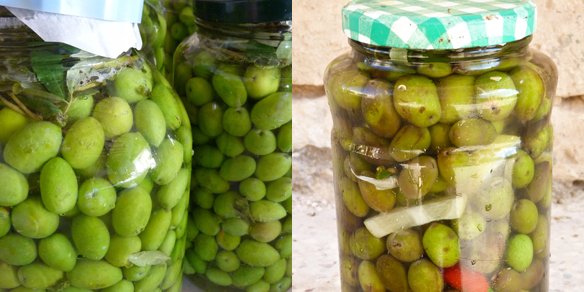The quantities in these recipes are very loose. Preserving olives is such a trial and error formula. I gave up after two consecutive bad years but am inspired to try again after helping make these.
Black
You’ll need about 5kgs of large black olives
Most of the ingredients we have used are fresh from Daria’s garden so please use organic products when you can.
Prick each olive with a fork 3 or 4 times. Into a large bowl throw the olives and 3–4 handfuls of rock salt. Mix well with your hands and leave in the bowl for 24 hours.
The following day remove the excess water from the bowl and mix the olives well with your hands. Put the mixture in a wicker basket (or something that will breath and drain), pat firmly, place a plate on top to cover the surface and put something heavy on top of the plate. Place the basket on another plate or bowl to catch the excess water and separate the two with something that will give the basket a bit of height so it doesn’t sit in the water.
Repeat this process every day for a week, returning the mixture to the basket with the weight on top.
On the eighth day add to the mixture approx. 2 heads of garlic (cloves separated but with the skin on), 6–8 whole long red chilies, stalks of wild fennel (or organic fennel seeds), a handful of dried thyme (or oregano if you don’t have thyme) and a handful of olive leaves and mix well. Return to the basket with the weight on top.
Turn out the mixture every day for a week, mix well with your hands and return the mixture to the basket with the weight on top. On about the eleventh day add a sliced lemon to the mixture.
Throughout these first two weeks, if there is humidity in the air, there is a risk that mold will form. The olives can be spread out and dried in the sun as often as every two days. You will need to determine this by sight and smell. If there is no sun or you do not have the space for open-air drying you can dry them in the oven. Simply heat up the oven then turn it off. Once it has cooled a little spread the olives on a couple of trays an put them in the oven. You can leave them there until the oven becomes cold. The oven method does not need to be repeated as often as open-air drying.
The olives should now be ready to taste. If they are still bitter then you should continue turning out the mixture every day until you are happy. Remove the lemon, chilies, olive leaves and garlic.
Put a couple of handfuls of olives in a bowl and add some good quality olive oil. Using your hands make sure the olives are well coated. Repeat the process with all the remaining olives. To the olives then add two heads of garlic (cloves separated, skin on – we smashed them lightly with a pestle to release the flavour), a handful of chilies, fennel seeds, dried basil, the leaves from 4–5 stalks of rosemary and mix well with your hands. Put the mixture into freezer bags in portions of your liking, removed as much air as possible, close, freeze.
Hang on! The olives are actually ready to eat now so you should keep one bag out to have with some freshly baked bread and a good bottle of red wine.
Green
You’ll need about 5kgs of large green olives without blemishes
Place the green olives in a bowl and cover with water. Add a handful of dried basil and a few handfuls of rock salt.
Every couple of days change the water, adding more salt to the fresh water each time.
After a few weeks place the olives in a large jar (or several smaller jars) with sliced lemon and some fennel seeds.
You now need to make a brine. The right quantities of salt and water for the brine is measured using a very fresh egg so it’s good if you have chickens. Dissolve the salt in the water. If the egg floats easily (about one third above the water) then it is right. If it sinks you need to add more salt. I have no idea how to do this without the fresh egg method but I did taste the brine and it was very salty.
Add the brine to the olives in the jar. Sprinkle the top with more fennel seeds and a garland made from a young olive branch. Place the lid on and store for 2–3 months. Unfortunately I wont be here to taste them when they are ready but they do look good!



Love it !
Hi Deanna
How timely. I have olives that keep dropping into my garden from the neighbour’s tree and had been wondering how to use them. Thanks so much. xx
Zoe